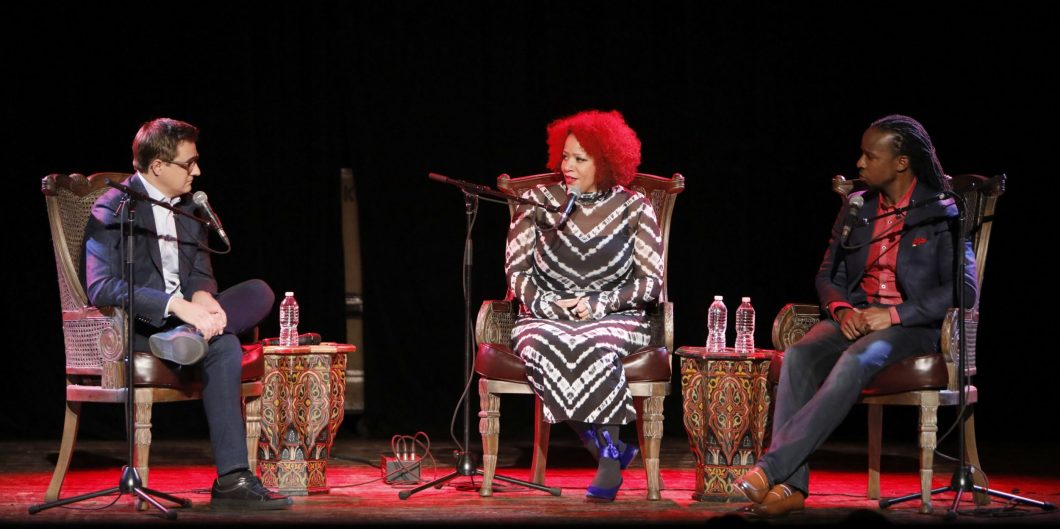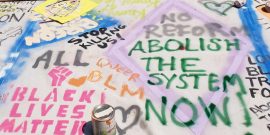America's principles can be sustained only through the existence of an independent nation-state, whose citizens enjoy the responsibility to preserve them.
Slouching Toward Totalitarianism
Amidst all the other tribulations visited upon these United States in 2020, we find ourselves—like a frog in the proverbial pot of boiling water—immersed in the suddenly-ubiquitous delusion of wokeness. With startling abruptness, concepts and terminology previously at the periphery of popular culture—“white privilege,” “systemic racism,” “unconscious bias,” and the like—have become household terms. Once seemingly limited to the fever swamp of academia, and even then mainly confined to a few humanities disciplines, the death of George Floyd catapulted the long-simmering (and frequently-ridiculed) rhetoric of wokeness into the headlines. Without warning, fringe organizations like Black Lives Matter unexpectedly became mainstream—complete with corporate sponsorships and celebrity spokesmen.
A revolutionary moment emerged almost overnight. Across America, employers’ human resources departments revamped anodyne compliance training into Maoist indoctrination sessions. As Christopher Rufo reported, this radical transformation is not limited to a few tech companies in Silicon Valley; it is happening—with revolutionary fervor—everywhere, including the U.S. military and Sandia National Laboratories, the federal contractor responsible for maintaining our nuclear arsenal. The New York Times’ mendacious 1619 Project received the 2020 Pulitzer Prize for Commentary, despite fierce criticisms by many leading historians who found it factually inaccurate—an anti-American screed on the scale of Howard Zinn’s controversial and influential A People’s History of the United States(which was largely responsible for the demonization of Christopher Columbus).
The criticism of the 1619 Project went unheeded—this is a revolutionary moment, after all! Did the Jacobins pause before purging their enemies in the Reign of Terror? Of course not. The 1619 Project has been obligingly adopted by many school districts as a template for teaching U.S. history. Some readers will point out that the developments leading to the current state of wokeism did not happen all at once, but have been percolating for decades. Fair enough. Critical race theory, the framework for the current wave of wokeness, is a variant of post-modern intellectual movements such as Marxist critical legal studies, and deconstructionism (usually associated with Jacques Derrida and Michel Foucault), which have been around for decades. Allan Bloom’s prophetic critique of higher education, The Closing of the American Mind, was published in 1987. In the intervening 33 years, things have only gotten worse. Much worse.
Cultural Marxism, pioneered by Italian political theorist Antonio Gramsci, adapted the paradigm of class struggle (the rise of the proletariat) to a contest for intellectual control (or “ideological hegemony”) of social institutions, such as schools and churches. The goal was to redefine bourgeois culture on behalf of the “oppressed,” not just the “exploited.” Gramsci therefore inspired the Left’s “long march through the institutions,” which has been stunningly successful. Identity politics has spawned numerous academic disciplines focused on different groups’ “oppression” at the hands of heteronormative white males deriving power from a capitalist economic system predicated on private property. Nearly every college in America now offers a major in such “grievance studies,” with more “marginalized groups” being identified each academic year. Self-professed victims of oppression abound. The perceived sins of the ostensible oppressors grow commensurately.
The election of President Donald Trump in 2016 fueled a bitter resistance among Democrats and progressives who viewed Barack Obama as the harbinger of a new—postconstitutional—era in America. Progressive writers such as Ta-Nehisi Coates gave voice to those feelings and tapped into popular audiences with books and journalism featuring identity politics. Coates’ Between the World and Me (2015) was a best-seller and won the National Book Award. Until recently, however, the obscure dogma of critical race theory itself held sway only on college campuses and in certain intellectual salons. Or so it seemed. Then, precipitated by the death of George Floyd in Minneapolis, this radical ideology swept into the public consciousness.
“Anti-racism” became the new tulip craze; wokeness, the latest mass delusion. Many white Americans have become obsessed with purging the original sin of their ancestry and heritage. Robin DiAngelo’s White Fragility (2018) flew off the shelves, and Ibram X. Kendi, author of the blockbuster How to Be an Anti-Racist (2019), quickly became one of the country’s most prominent academics. The woke catechism of anti-racism misleadingly uses the vernacular of the civil rights movement to advance an agenda radically at odds with any sensible conception of racial equality. Wokeness is promoted in many churches—and even by my local public library in small town Tennessee. What are the tenets of this new creed, critical race theory (CRT)?
White people are inherently racist, the disciples of wokeness assert. Denying this merely confirms the verdict. Because racism is baked into the structures and institutions of our society (manifesting itself in idealized traits such as punctuality, merit, and industry—references to which are denounced as “microaggressions”), white people inevitably exhibit “unconscious” bias against members of marginalized (or “oppressed”) groups. All white people unfairly enjoy an advantage—“white privilege”—as members of the oppressor class. Statistical disparities among demographic groups (in terms of income, educational achievement, criminality, and so forth) are necessarily and solely the result of racism.
Not only has an entire generation of college students been indoctrinated by woke dogma, the Left has gained control of many public-school systems.
Indeed, Kendi contends that capitalism itself is “essentially racist,” due to the end-result disparities it tolerates. (By the same perverse logic, freedom itself is racist.) Therefore, Kendi maintains, all such disparities must be eradicated through government intervention. To this end, Kendi advocates a constitutional amendment that would mandate “racial equity” (end-result equality) and create a federal “Department of Anti-Racism” to ensure such outcomes in all spheres of life. State-mandated sameness is the antithesis of the Founders’ design—the abolition of a free society: Antonio Gramsci meets Harrison Bergeron. Critics contend that “Kendi’s goals are openly totalitarian.” Instead of resisting this hostile ideology, today’s woke business leaders enthusiastically support it. (Twitter CEO Jack Dorsey recently announced that he was donating $10 million to Boston University’s Center for Antiracist Research, a project recently launched by Kendi.)
“Wokeness,” in other words, requires the destruction of a constitutional democracy based on equality under the law and the primacy of consensual exchanges in a free market. This is not the message of reconciliation and color blindness preached by the Rev. Martin Luther King Jr. In fact, the toxic rhetoric of BLM—now in vogue—recalls the radical liberation movement of the 1960s and 70s symbolized by the Black Panther Party, Angela Davis, and others who openly advocated revolution. Since then, alas, the long march has succeeded in the Left’s capture of higher education, including the critically-important colleges of education that train most K-12 teachers and administrators. Not only has an entire generation of college students been indoctrinated by woke dogma, the Left has gained control of many public-school systems.
Which brings us—finally—to the most recent example to receive media attention: the (now temporarily-withdrawn) proposal being considered by the school board in Loudoun County, Virginia that would adopt CRT (euphemistically labeled “Action Plans to Combat Systemic Racism”) as the school system’s official policy. Not only would this noxious doctrine be foisted upon Loudoun County schoolchildren, but teachers would be subject to discipline if they publicly disagreed with CRT—even in private speech off-campus and on non-working time. This government-enforced speech code is a clear violation of the First Amendment. The proposed policy forbids Loudoun County teachers to express disagreement with CRT and requires them to snitch on colleagues who do. Critics call the proposed policy “tyrannical” and charge that Loudoun County schools would become “ideology factories,” and rightly so.
This Orwellian policy has been denounced as “a rush to soft totalitarianism,” but recent events illustrate how quickly things can metastasize. Totalitarianism, whether “soft” or “hard,” has no place in America. Loudoun County is not a rural backwater or hipster enclave resembling Portland or Brooklyn. It is a wealthy suburb of Washington, D.C., and one of the nation’s most affluent communities. If this could happen in Loudoun County, it could happen anywhere. Only after a barrage of negative publicity did administrators announce that adoption of the proposed policy would be postponed to allow for its “clarification.” The pushback, initiated by the union representing many Loudoun County teachers, focused on the speech code, not the rest of the CRT agenda. Whatever finally emerges is likely to embrace race norming, educational “equity,” and (in the words of draft policy) “socially-just teaching.” This is code for wokeness.
One reason CRT was able to become ascendant is that most individuals—citizens, commentators, and elected officials—were reluctant to criticize it, or even to acknowledge its creeping advance, out of fear of being accused of racism. A courageous, independent-minded engineer at Sandia National Labs, Casey Petersen, changed that when he confronted his employer about a mandated training class containing CRT themes he found objectionable. When unable to obtain satisfactory responses from Sandia, Petersen created a detailed (and impressively-cogent) YouTube video that was widely circulated. It came to the attention of Christopher Rufo, who wrote about it, which led to Rufo’s appearance on Tucker Carlson Tonight, which in turn prompted President Trump to take executive action to ban the use of CRT training for federal employees and contractors.
One man triggered a chain of dominoes, demonstrating the power—and necessity—of individual action. Edmund Burke is reputed to have said that “The only thing necessary for the triumph of evil is for good men to do nothing.” If we are to avoid the ruination of our country by CRT, we must slouch no more, and oppose it.



